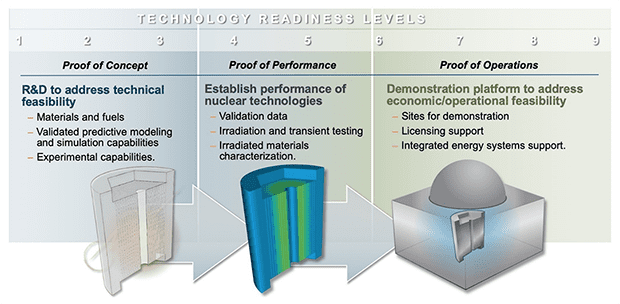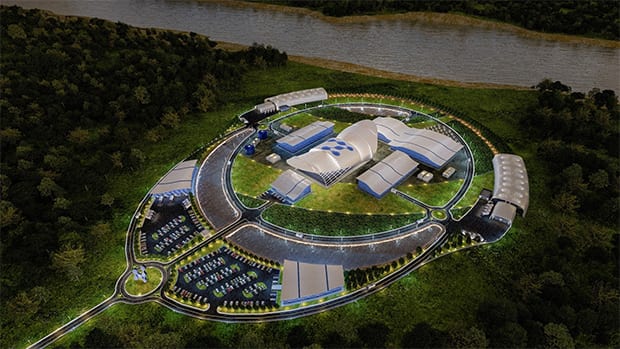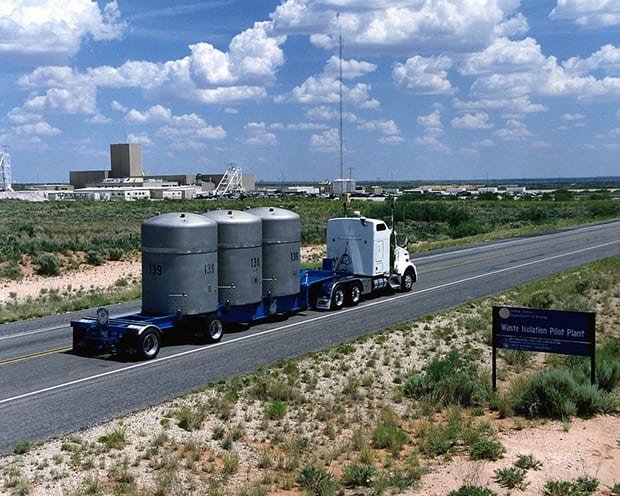Small Modular Reactors Have High-Level Support
U.S. Department of Energy (DOE) Secretary Rick Perry is headed to Brussels, Belgium, to promote small modular reactor (SMR) concepts to European Union (EU) prospects. Perry will be a featured speaker during the “1st U.S.-EU High-Level Industrial Forum on Small Modular Reactors,” which will be held Oct. 21.
“The U.S. and the EU share a very rich history of mutually beneficial cooperation on nuclear energy, and this is just a continuation of it and I think a revitalizing of that international effort so that we can share our technologies with our friends and our allies,” Perry said during a press briefing on Oct. 16.
The majority of new nuclear power plants currently planned or under construction are large, light water-cooled units. SMRs represent an alternative solution, with state-of-the-art technological features that advocates say offer safety advantages.
SMR designs vary in size from less than 20 MW to several hundred megawatts. They can be used for power generation, process heat, desalination, and other industrial uses. SMRs can employ a range of possible coolants including light water, liquid metal, or molten salt, depending on the technology.
Partnerships Flourishing
The international forum in Brussels is expected to bring business stakeholders and government authorities together in an effort to further public-private partnerships and move SMR technology forward.
“We absolutely do see opportunities for collaboration with our European Union counterparts,” said Samuel Buchan, a special advisor and assistant to the secretary in the DOE’s International Affairs office. “We have a number of [EU member states] that already reached out to sign memorandums with various private-sector entities within the U.S. developing this technology including Poland, the Czech Republic, and Romania.”
Assistant Secretary for Nuclear Energy Rita Baranwal noted that a memorandum of understanding (MOU) was recently signed by some big nuclear power players. “While we were at the IAEA [International Atomic Energy Agency] General Conference in Vienna a few weeks ago, I was able to witness the signing of an MOU between Westinghouse, EDF, and CEA in France, of a project that they are calling NUWARD—so, ‘nuclear forward,’ if you will, NUWARD. And that is focused on an SMR concept that is 300 to 400 MW electric,” she said.
Perry, meanwhile, pointed to a couple of domestic developments that are helping support the nuclear industry. “In September 2018, as you all will recall, President Trump signed the [Nuclear Energy Innovation Capabilities Act] into law. That’s going to speed up the development of advanced reactors in the United States. As a result, the Department recently established the National Reactor Innovation Center—NRIC—to speed up the licensing and commercialization of advanced reactors [Figure 1]. So, Idaho National Labs, in Idaho Falls, Idaho, that laboratory is going to be where the NRIC provides a platform for U.S. companies to assess the performance of their reactor concepts through testing and demonstration. So, it’s a classic public-private partnership,” Perry said.
 |
| 1. The DOE says NRIC provides capabilities to accelerate technology readiness from proof of concept through proof of operations. Source: DOE |
Long-Term Solutions for Nuclear Waste a Concern
Although SMRs generate a smaller amount of waste than some other reactor technology, there is still a need to dispose of radioactive material. The U.S. is still without a long-term solution to the nuclear waste disposal problem.
“The administration is still working toward finding the solutions,” Perry said. “We’ve got waste, I think, in 38 different states that we’ve got to deal with. And the idea that we’re just going to leave this waste in these temporary sites that weren’t built for any long-term storage at all, it’s not appropriate. Frankly, it’s immoral.”
Perry said he supports the Yucca Mountain facility as a long-term solution. He noted that the Waste Control Specialists (WCS) facility near Andrews, Texas, and the Waste Isolation Pilot Plant (WIPP) outside of Carlsbad, New Mexico, also offer options for some nuclear waste.
WCS calls itself “a one-stop shop for the treatment, storage, and disposal of Class A, B, and C low-level radioactive waste, hazardous waste, and byproduct materials.” WIPP, meanwhile, was constructed for disposal of defense-generated transuranic (TRU) waste from DOE sites around the country. TRU waste consists of clothing, tools, rags, residues, debris, soil, and other items contaminated with small amounts of plutonium and other man-made radioactive elements. The waste is permanently disposed of in rooms mined in an underground salt bed layer more than 2,000 feet from the surface. WIPP has been in operation since 1999 (Figure 2).
“We’ve got some sites. We need to get our sights set on politically doing this for the sake of the country,” Perry said.
Baranwal also supports Yucca Mountain as a long-term option. “I do still firmly believe that Yucca Mountain in the United States is the technically best solution to store used fuel. I’ve personally toured that facility in late August. It is a remarkable engineering feat, and personally, I think it’s a shame that we have not yet been able to utilize that,” she said.
Challenges to SMR Deployment
While SMRs do produce less radioactive waste, that’s not the only benefit of the technology. Among other advantages are better financing options due to reduced construction schedules, fewer components and smaller plant footprints, ease of construction, flexibility, improved physical security, and the potential for independent operation from the grid.
Still, the path to widescale SMR deployment remains long. Challenges exist in validating the business case for SMRs, assuring predictable and streamlined licensing processes and frameworks, developing global supply chains to ensure profitability, identifying suitable nuclear sites, and achieving a transparent dialogue model between the concerned stakeholders.
In the U.S., the NuScale Power SMR design (Figure 3) has made the greatest progress toward Nuclear Regulatory Commission (NRC) approval. “The next phase of licensing with the NRC on the NuScale concept is on track for January 2021, which then puts NuScale on track for their 2026 deployment,” Baranwal said. “Countries are looking at NuScale and the progress that is being made, and so we’re very optimistic that once we are able to demonstrate this technology in the United States, we will have many other interested countries wanting to import this technology.”
 |
| 3. An artist’s rendering of a NuScale SMR site. Courtesy: NuScale Power |
“I think there’s been a real mindset change at the DOE, which has filtered out through the country,” Perry said. “There is a new energy. There is a new excitement. There is a new day for civil nuclear power in America.”
—Aaron Larson is POWER’s executive editor (@AaronL_Power, @POWERmagazine).
